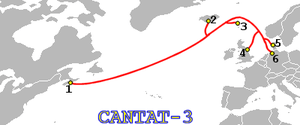CANTAT-3
CANTAT-3 was the third Canadian transatlantic telecommunications cable, in operation from 1994 to 2010, initially carrying 3 x 2.5 Gbit/s between Canada and Europe. It branches to both Iceland and the Faroe Islands.[1]
| CANTAT-3 | |
|---|---|
 | |
| Owners: STC Submarine Networks, Portland, Oregon, USA and STC Submarine Networks in Southampton, Hampshire, UK | |
| Operator: VSNL International Canada | |
Landing points
| |
| Design capacity | 2.5 Gigabit/Second |
| Technology | NL-16 laser regenerative |
| Date of first use | 1994 |
On December 17, 2006, CANTAT-3 services were disrupted due to damage to the submarine cable, resulting in degradation of service to hundreds of thousands of users connecting via internet and media providers (Síminn, Vodafone and Hive). The country was however backed up by the second submarine cable, FARICE-1 The most notable effect of the event was a temporary shut-down of data communications by Iceland's universities and hospitals, which relied exclusively on CANTAT-3's services. Although it was predicted that a full recovery of the cable would take ten days, starting from midnight on January 13, 2007, it actually took until July 29, 2007 before service was fully restored. During that time, the Icelandic universities and hospitals in Akureyri and Reykjavík relied on emergency connectivity obtained via local internet providers Síminn and Vodafone. The Icelandic government decided not to buy extra bandwidth for the university network through the functioning FARICE-1 cable, despite being a large shareholder in FARICE-1.[2]
Landing points are:
- Pennant Point, Nova Scotia, Canada
- Vestmannaeyjar, Iceland[3]
- Tjørnuvík, Faroe Islands
- Redcar, North Yorkshire, UK
- Blaabjerg, Denmark
- Sylt, Germany
CANTAT-3 was operated by India's Teleglobe.
CANTAT-3 was the only NL-16 laser regenerative 2.5 Gig/s submarine system built in the world.[4] Part of this huge system was built at STC Submarine Networks, Portland, Oregon, USA, from 1993-1994 (which later became Alcatel Submarine Networks). STC Submarine Networks in Southampton, Hampshire, UK. made the rest of the system. The Canadian portion (shore end system) was laid off Nova Scotia by the Teleglobe cable ship CS John Cabot. The main-lay portion was deployed off Nova Scotia towards the Faroes on board the AT&T ship Global Mariner. Other cable ships were involved in the completion of this system. This was the northern most cable system ever deployed at the time.
Given that CANTAT-3 suffered multiple[1][5] interruptions, the alternative cables FARICE-1, DANICE and Greenland Connect were established and/or expanded[1] to ensure cabled telecommunication connectivity in Iceland. CANTAT-3 also had too little capacity by 2007 for domestic Internet usage and became outdated as soon as the DANICE cable came into operation by 2009. The Iceland, Denmark and Germany portion of CANTAT-3 is still in use (2016) and is powered from Iceland and connected to Sylt in Germany and Blaabjerg in Denmark. This portion of the cable is now connected to several oil platforms in the North Sea and that is the primary function of CANTAT-3. The current owner of CANTAT-3 is the Farose Telecom (Föroya Tele). The transatlantic portion is no longer in operation and has not been replaced.
Notes
- Farice: The background of the FARICE-1 cable
- Press release by Síminn at 2006-12-17 about failure of CANTAT-3 Archived 2013-09-18 at Archive.today (Icelandic)
- "Press release by Míla ehf. and Føroya Tele about CANTAT-3 operations in Iceland". Archived from the original on 2013-09-18. Retrieved 2013-09-18.
- "12.17 ODIN Cable System". Greenland Theory. Retrieved 31 December 2018.
- Press release by Síminn at 2003-11-05 about failure of CANTAT-3 Archived 2013-09-18 at Archive.today (Icelandic)
References
- The Iceland Basin, -Topography and Oceanographic Features-, Svend-Aage Malmberg, Marine Research Institute, Reykjavík 2004. Accessed 13 January 2006. Map of CANTAT-3 cable route on p13.
External links
- 2003 Nordunet Annual Conference
- TeleGeography.com: New submarine cable to dramatically increase Iceland’s data transmission capacity, Monday, 9 February 2004
- Islands of Resilience: Comparative Model for Energy, Connectivity and Jurisdiction - Realizing European ICT possibilities through a case study of Iceland Accessed 30 January 2013.